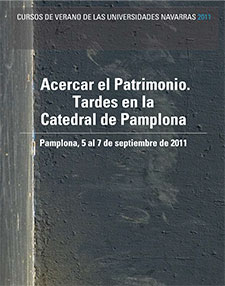BRINGING HERITAGE CLOSER. EVENINGS IN PAMPLONA CATHEDRAL.
5 September 2011
Views of travelers in front of Pamplona Cathedral
Ms. Carmen Jusué Simonena. UNED of Pamplona
An exciting literary chapter is that of the visions about the Cathedral of Pamplona or about the city itself, transmitted by the travel books of foreign authors or from outside Navarre. It is, at the same time, a very long chapter, both in time, because we have literary testimonies of a wide space of time, and in space, because such travel stories are scattered among the different languages of Western Europe.
Sometimes the traveler speaks to us through data of first hand, fruit of lived experiences, of roads traveled, then his testimonies are very interesting, and, at the same time, very varied, since they include the religious, the geographical, the historical, the anthropological, the ethnographic, the artistic..., areas that help us to form a very faithful drawing of how those who have visited us have been seeing us throughout history, at the same time that they contribute us data very valuable about our past, in its different aspects.
We have chosen a group of travelers who made different trips through Spain and, when they stopped in Pamplona, they made different appreciations of the cathedral and its façade. Some of them offer brief news, but others make extensive and curious descriptions. Evidently they could have been others, however, the selected ones reflect, each one in their own way, a different vision, which leads us to appreciate more or less poetic, more or less dark or more or less descriptive nuances.
Among all of them, perhaps because of their extensive descriptions, it is worth mentioning the impressions written by A. Jouvín, a Frenchman from Rochefort who published in Paris a work entitled El viajero de Europa (1672), the second volume of which contains the news he gives of Spain and Portugal. He describes Pamplona in a very simple way and about the cathedral he only says: the main church that is episcopal, whose tower is very high... or the Journey of Spain (1772-94) of the Valencian Antonio Ponz (1725-1792), secretary of the Royal Academy of San Fernando that elaborates, in epistolary form, an inventory of monuments of several regions. It is not limited to artistic objects, but reflects agriculture, climatology, etc. and, above all, the writer Victor Hugo (Besançon, 1802 - Paris, 1885), the greatest figure of French Romanticism, was a poet, novelist and playwright. After his previous brief stay in Spain, he returned on a short trip in 1843. In addition to the impressions he narrates in his posthumously published work, Alpes et Pyrénées, details of his trip are known from the book Le voyage de Victor Hugo in 1843. France - Espagne - Pays Basque, by the French writer Gilberte Guillaume-Reicher published in Paris in 1936. According to the author, Victor Hugo was strongly inspired by the haughty, mystical and joyful capital of Navarre, a city multiple and unique, so old and so full of history, and so young at the same time in the murmur of its fountains and the scent of its jasmines.
PROGRAM
Monday, 5th September
The Cathedral in the History of Navarre: the cathedral, the chapter, the institutions and the bishop.
D. Luis Javier Fortún Pérez de Ciriza. Royal Academy of History
Capitals and keystones of the Cloister of Pamplona Cathedral. That unknown world
Ms. Clara Fernández-Ladreda Aguadé. University of Navarra
Travellers' views of Pamplona Cathedral
Ms Carmen Jusué Simonena. UNED of Pamplona
Tuesday, 6th September
Sumptuary arts in the Cathedral
D. Ignacio Miguéliz Valcarlos. Chair of Navarrese Heritage and Art
Artists in the Cathedral. Esteban de Obray, master of choir stalls.
Ms. María Concepción García Gainza. Chair de Patrimonio y Arte Navarro
A stroll through the canonical dependencies of the cathedral
Mr Javier Martínez de Aguirre. Complutense University of Madrid
Duplicate visits to the cathedral complex in Pamplona
Wednesday, 7th September
Golden scenery: the baroque altarpieces
D. Ricardo Fernández Gracia. Chair of Heritage and Navarrese Art
The cathedral today and tomorrow: projects in progress
D. Francisco Javier Aizpún Bobadilla. Episcopal Vicar for Heritage. Archbishopric of Pamplona
CLOSING: Concert at position Choir Santa María la Real de Voces Graves

